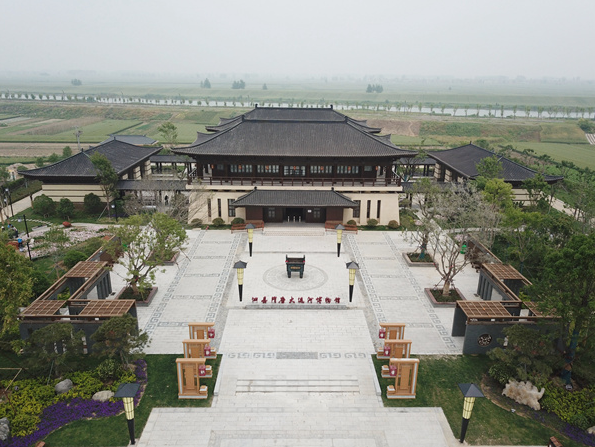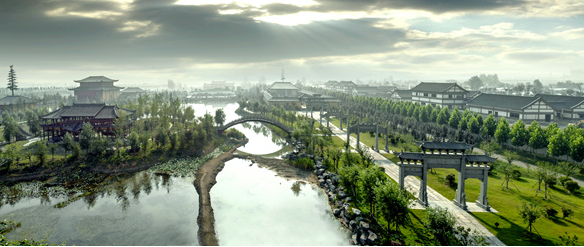A flow of history

The Sixian section of the Grand Canal is a cultural treasure, Yang Feiyue reports.
A section of the ancient Grand Canal brims not only with a beautiful legacy of the past but also benefits the locals of today and tomorrow.
A green channel still runs through Sixian county, Suzhou, in East China's Anhui province. Vast verdant fields spread from its banks as far as the eye can see, interrupted only by a wooden pavilion and a stone bridge that spans the waterway.
Don't be fooled by its plain look. The 5.8-kilometer stretch of the canal has been flowing nonstop for more than 1,000 years and was one of the sections of the ancient Grand Canal that was granted UNESCO World Heritage status in June 2014.
"The section has retained its original condition, such as the bed's structure, pretty well," says Zhang Su, a Grand Canal historian with the Sixian cultural relics management center.
The Grand Canal once flowed 3,200 kilometers from Beijing in the north to Zhejiang province in the south. It used to be a major transportation artery running through ancient China, with a history dating back 2,500 years. The canal functioned as the backbone of the ancient empire's inland communication and trading systems, transporting grain and strategic raw materials. It has long played an important role in ensuring the country's economic prosperity and stability.

The canal, the construction of which peaked during the Sui (581-618) and Yuan (1271-1368) dynasties, connects several key rivers across the country, including the Yangtze, Huaihe and Yellow rivers.
In AD 605, Emperor Yang of the Sui Dynasty employed a massive labor force to dig the canal, linking the ancient capital of Luoyang in Henan province to Suzhou via the Yellow River and Huaihe River.
The Grand Canal once ran 180 km through Anhui, but most of it has since dried up due to both natural and human factors, and only Sixian has preserved 28 km of the once-majestic waterway.
The flowing water, ditches, embankment and wild ducks make for a picturesque view of the historic cultural corridor. Perhaps what is more surprising is that the ancient Grand Canal section still plays a positive role in local irrigation, flood diversion and tourism.
Water from the Yellow River carried a great deal of silt, which could easily block up certain sections of the Grand Canal, Zhang explains.
After the ancient capital moved to Beijing during the rule of Emperor Shizu (Kublai Khan) of the Yuan Dynasty, parts of the Grand Canal that were built during the Sui and Tang (618-907) dynasties fell into disuse.

Some sections of the ancient Grand Canal to the north of the Yellow River currently hold no water.
The Sixian section has survived the test of time, thanks to its natural geographical advantage and continuous protection by the population along its banks, Zhang says.
Although the 28-km waterway has retained the same appearance as it had when it was first built, most parts were deemed short of meeting the UNESCO World Heritage qualification.
"Some older waterway maintenance work has accidentally compromised some of the original bed's structure," Zhang says, adding that only the aforementioned 5.8-km section has survived intact.
Things on that stretch of canal began to look up in 2007 when preparation work got underway for the UNESCO application.
Over the years, the county's administrators have worked to improve the environment around the Grand Canal section. Shanties have been relocated, and sewage systems have been put in place, says Wang Yongle, an official with the county's publicity department. Personnel have been assigned to regularly maintain the canal's environment.
Yu Chao was born and bred on the banks of that original stretch of the canal and has witnessed significant changes in his neighborhood.
"My family used to live in thatched and tile-roofed dwellings among the farmlands along the canal," the 34-year-old says.
The area was plagued by litter and domestic rubbish from the rural households, and pigs and fowl were let loose on the farmland, he recalls.
"The air stank."
But, the canal somehow managed to avoid human-created pollution, and Yu says that, as a child, he would watch fish swimming in the channel.
"Perhaps we, as locals, understood the importance of the waterway to our livelihoods," Yu says.

As soon as the site's historical value was realized in the 2000s, the wanton disregard for the surrounding environment stopped.
Rural output and animal husbandry have been scientifically managed, and polluting farms have given way to scenic green belts designed for sightseers and tourists.
"Everything looks much nicer and better organized now, and the air has become fresh," Yu says.
Yu's family was awarded compensation of about 40,000 yuan ($6,216) per mu (1/15th of a hectare) of land and was relocated to a nearby apartment building.
Local authorities have focused on the protection, inheritance and use of Grand Canal culture.
Since 2019, archaeological exploration has been carried out along the full 28 km to better understand the canal's condition.
The county invested more than 1 billion yuan in developing a cluster of 10 cultural facilities in the Grand Canal area, including the Sui-Tang canal and local family-traditions museums, a library and a theater.
The cluster covers an area of 30,000 square meters and provides sightseeing, intangible cultural heritage and performances, as well as social education.
Sixian is also planning a national-level Grand Canal park that will highlight the features of the Sui-Tang Grand Canal sections, as well as archaeological findings, Wang says.
After leaving home to undertake vocational education in Wuhu, Anhui province, and spending three years doing mechanical manufacturing work in Kunshan, Jiangsu province, Yu came back to the area in 2014, drawn by the allure of the Grand Canal.
"It was just thrilling to learn there's something to those childhood stories told by the elders," Yu says, adding that he couldn't help but imagine how an ancient emperor might have sailed down the canal and interacted with the residents on its banks.
He stumbled upon a collection of antiques after finding many rural household objects had been discarded, ranging from farming tools to daily necessities. Some, he believed, were over a century old.
"They had no use or space for them, especially after they got to move to a nice, modern apartment," Yu says.
Yu's hobby of collecting old coins and books in his childhood was rekindled. He went door-to-door, looking for antiques in his neighborhood, storing and displaying them in an old brickyard owned by his family.
"It was purely out of personal interest at first," he says.
But people began to knock on his door asking to see, and even buy, some of the old items.
"They were mostly visitors from outside the area, visiting after the canal section became well-known," he says.
It encouraged him to maintain the habit of collecting antiques.
"After a while, people started approaching me of their own volition, offering me things for my collection," Yu says.
Items included old-fashioned barn lanterns, flagons, copper locks, clocks, kettles, ceramics and abacuses.
In addition to the extra income from his antiques business, Yu says the greatest satisfaction lies in the interaction he has with guests coming his way.
"I love this land from the bottom of my heart, and I feel extremely happy sharing stories of its past and my memories of growing up on the Grand Canal with them," Yu says.